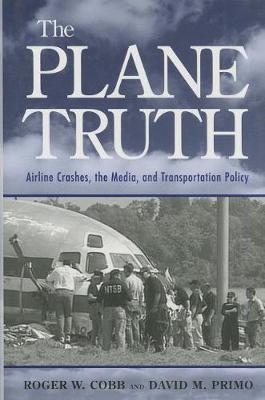
The Plane Truth
Airline Crashes, the Media, and Transportation Policy
Seiten
2003
Brookings Institution (Verlag)
978-0-8157-7198-2 (ISBN)
Brookings Institution (Verlag)
978-0-8157-7198-2 (ISBN)
- Titel ist leider vergriffen;
keine Neuauflage - Artikel merken
Flying is an extremely safe way to travel. Fewer than 14,000 individuals perished in U.S. airline disasters during the twentieth century. In contrast, nearly three times as many people lose their lives in automobile accidents every year.
Yet plane crashes have a tremendous impact on public perceptions of air safety in the United States. When a crash occurs domestically, media coverage is immediate and continuous. Government teams rush to investigate, elected officials offer condolences and promise to find the cause, and airlines and plane manufacturers seek to avoid responsibility. Regulations are frequently proposed in response to a particular incident, but meaningful change often does not occur.
In The Plane Truth, Roger Cobb and David Primo examine the impact of high-visibility plane crashes on airline transportation policy. Regulation is disjointed and reactive, in part due to extensive media coverage of airline disasters. The authors describe the typical responses of various players —elected officials, investigative agencies, airlines, and the media. While all agree that safety is the primary concern in air travel, failure to agree on a definition of safety leads to policy conflicts.
Looking at all airline crashes in the 1990s, the authors examine how particular features of an accident correspond to the level of media attention it receives, as well as how airline disasters affect subsequent actions by the National Transportation Safety Board, Federal Aviation Administration, and others. Three accidents are considered in detail: USAir flight 427 (September 1994), ValuJet flight 592 (May 1996), and TWA flight 800 (July 1996). The authors also discuss how the September 11 terrorist attacks turned attention away from safety and toward security.
Cobb and Primo make several policy recommendations based on their findings. These include calling on lawmakers and regulators to avoid reactive regulation and instead to focus on systematic problems in airline safety, like the antiquated air traffic control system. Concerned that aviation security is eclipsing aviation safety in the wake of September 11, they encourage federal agencies to strike a better balance between the two. Finally, in order to address the FAA's poor track record in balancing airline safety regulation with its other duties, they recommend the creation of a new federal agency that is responsible for aviation safety.
The Plane Truth provides a framework for understanding conflicts about the meaning of air safety and the implications of these battles for public policy.
Yet plane crashes have a tremendous impact on public perceptions of air safety in the United States. When a crash occurs domestically, media coverage is immediate and continuous. Government teams rush to investigate, elected officials offer condolences and promise to find the cause, and airlines and plane manufacturers seek to avoid responsibility. Regulations are frequently proposed in response to a particular incident, but meaningful change often does not occur.
In The Plane Truth, Roger Cobb and David Primo examine the impact of high-visibility plane crashes on airline transportation policy. Regulation is disjointed and reactive, in part due to extensive media coverage of airline disasters. The authors describe the typical responses of various players —elected officials, investigative agencies, airlines, and the media. While all agree that safety is the primary concern in air travel, failure to agree on a definition of safety leads to policy conflicts.
Looking at all airline crashes in the 1990s, the authors examine how particular features of an accident correspond to the level of media attention it receives, as well as how airline disasters affect subsequent actions by the National Transportation Safety Board, Federal Aviation Administration, and others. Three accidents are considered in detail: USAir flight 427 (September 1994), ValuJet flight 592 (May 1996), and TWA flight 800 (July 1996). The authors also discuss how the September 11 terrorist attacks turned attention away from safety and toward security.
Cobb and Primo make several policy recommendations based on their findings. These include calling on lawmakers and regulators to avoid reactive regulation and instead to focus on systematic problems in airline safety, like the antiquated air traffic control system. Concerned that aviation security is eclipsing aviation safety in the wake of September 11, they encourage federal agencies to strike a better balance between the two. Finally, in order to address the FAA's poor track record in balancing airline safety regulation with its other duties, they recommend the creation of a new federal agency that is responsible for aviation safety.
The Plane Truth provides a framework for understanding conflicts about the meaning of air safety and the implications of these battles for public policy.
Roger W. Cobb is professor of political science at Brown University, Rhode Island, USA. David M. Primo is assistant professor of political science at the University of Rochester, New York, USA.
| Erscheint lt. Verlag | 30.5.2003 |
|---|---|
| Sprache | englisch |
| Maße | 152 x 229 mm |
| Themenwelt | Sozialwissenschaften ► Kommunikation / Medien ► Medienwissenschaft |
| Sozialwissenschaften ► Soziologie | |
| Technik ► Luft- / Raumfahrttechnik | |
| ISBN-10 | 0-8157-7198-3 / 0815771983 |
| ISBN-13 | 978-0-8157-7198-2 / 9780815771982 |
| Zustand | Neuware |
| Haben Sie eine Frage zum Produkt? |
Mehr entdecken
aus dem Bereich
aus dem Bereich
wie KI und virtuelle Welten von uns Besitz ergreifen – und die …
Buch | Hardcover (2023)
Heyne (Verlag)
CHF 29,90
Eine Einführung
Buch | Softcover (2022)
Springer VS (Verlag)
CHF 46,15


